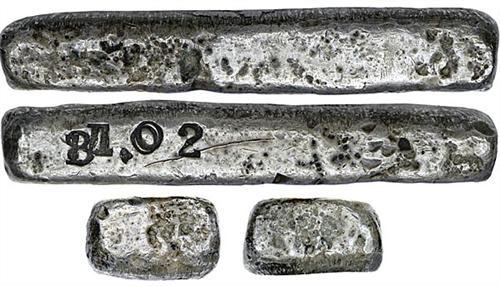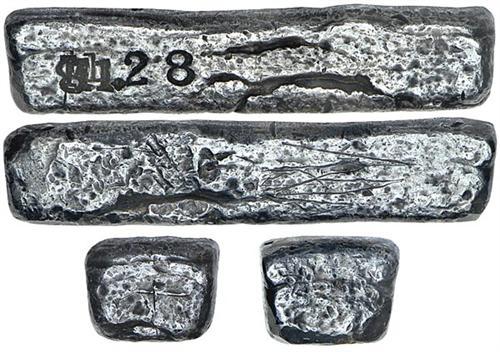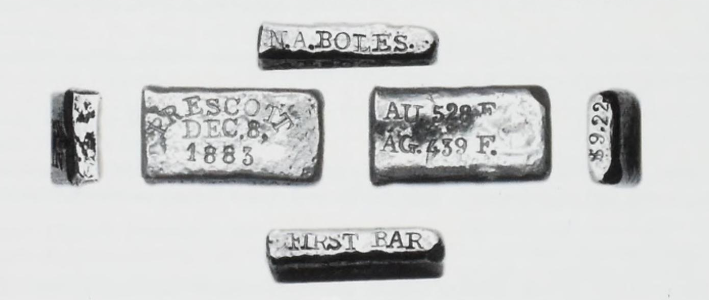$1.02 N.A. Boles, Assayer. Prescott, Arizona. Silver assay ingot.


Overall appearance of Fine. A very rough, crude, and unfinished bar almost straight from the mold. Medium silver gray color. The surfaces are rough and pitted, the faces are unfinished, and the legends are accomplished in individual punches. The $ punch was made by punching a 1 over an 8. The bar does not state more about its content or value than its apparent silver fineness and total value. Presumably, the bar’s owner knew enough he did not have to ask for more.
The piece resembles the first of the Thomas Price & Son bars to follow. The “F”, “8”, and “N”, “A”, and “B” punches on these two Boles bars are identical. These two ingots attributed to Boles are consistent in shape, size, weight, use of individual punches, and layout of the information about fineness and value. Both use the odd expedient of punching a 1 over an 8 to make something resembling a $. Both place the fineness of the bar on the left side of the face but neither indicates the metallic content, presumably leaving it up to the owner’s common sense. Neither indicates the bar’s value in any other way than a simple dollar value.
Face: At left, F 828 above N A BOLES.
- Back: blank.
- Top side: 8/1 [to create a $] 1.02
- Bottom side: blank.
- Left side: blank.
- Right side: blank.
- Dimensions: 54.1 x 14.9 x 9.3 mm.
- Current weight: 67.30 gms.
From the John J. Ford, Jr. Collection
Provenance: Ex Century Collection (Superior Galleries, February 2, 1992, lot 3430).
[10/2007] https://auctions.stacksbowers.com/lots/view/3-AV6LD/na-boles-assayer-prescott-arizona-silver-assay-ingot ($18,400)
N.A. Boles, Assayer. Prescott, Arizona. Silver assay ingot, December 15, 1883.


Overall appearance of Fine. Another rough, crude, and unfinished bar from this maker. Somewhat deeper silver gray color. Like the first, surfaces rough and pitted, the faces unfinished, the legends accomplished by individual punches. The face is scratched. The cataloguer knows of one other ingot marked by Boles besides these two, the $9.22 bar dated December 8, 1883 that was first shown to Stack’s in September, 1989 and that ultimately appeared in Stack’s sale of January 15, 1997, lot 1281 (sold at $17,600).
Once belonging to Col. Green, it is a silver specimen dated December 15, 1883, of 986 fineness advertised in the February 1956 issue of the Numismatic Scrapbook Magazine and now in a Western collection.
- Face: At left, 986F, below and to the right of which N.A.B., above and to the right 12.15.83.
- Back: blank.
- Top side: 8/1 [to create a $] 1.28
- Bottom side: blank.
- Left side: blank.
- Right side: blank.
- Dimensions: 51.3 x 14.3 x 11.4 mm.
- Current weight: 77.19 gms.
From the John J. Ford, Jr. Collection
Provenance: Ex Colonel Green and Charles A. Kays (Schulman, 1956) Collections, Dan Brown’s Coin Shop, Inc. on August 17, 1970. Mr. Ford’s informational card, Rankow photographs, and purchase invoice accompany the lot.
[10/2007] https://auctions.stacksbowers.com/lots/view/3-AV6LJ/na-boles-assayer-prescott-arizona-silver-assay-ingot-december-15-1883 ($13,800)
Unidentified “O.M.” $4.48 Silver Ingot


Style of N.A. Boles, Prescott, AZ
Undated (Circa 1880s?) Silver Assay Ingot. Crude VF.
53.5 x 14.1 x 14.3 millimeters. 107.64 grams / 3.46 Troy ounces. Pleasing and original darkly toned silver. Only the top face has been marked: O M / $4 48.
At a value of $4.48 and a weight of 107.64 grams, this ingot corresponds to essentially pure silver at $1.29 per ounce, the prevailing price from 1878 though the mid 20th century.
The size and shape of this bar is nearly identical to Ford XX:351, and its general fabric is also essentially similar. That piece, assayed by N.A. Boles of Prescott, Arizona, was produced in 1883. It was miscataloged as having a value of $1.28; the bar is actually a $4.28 bar. Like the Boles ingots, this piece shows no corner assaying cut. The two Boles ingots in Ford, both of which present nearly the same shape and size, echo the size and fabric of the first Thomas Price ingot, Ford XX:3532. Price, an assaying instructor, may have been Boles’ teacher, and it seems like that if Boles did not make this ingot, another of Price’s students or associates did.
The M of the OM inscription probably stands for “mine” or “mining,” but the O could stand for almost anything. Given its texture and content, this very pure silver bar is probably from Arizona in the last quarter of the 19th century.
It is clearly not a presentation bar. Its lack of marked fineness or weight suggests that whatever recipient it was intended for–a melter or employee–would have known that it was silver and essentially pure. Crude but charming, historic but enigmatic, a fine type example of the sorts of small bars that were used as short-term currency in mining districts throughout the American West.
[01/2012] https://auctions.stacksbowers.com/lots/view/3-2BRJ9/undated-circa-1880s-silver-assay-ingot-crude-vf ($489)
$9.22 A mixed Assayer’s Conversion Ingot, by N.A. Boles of Prescott, Arizona, dated December 8, 1883.

- Obverse: Prescott / Dec. 8, / 1883.
- Reverse: AU. 528F. / AG. 439 F.
- Stamped on the sides at at one end: N.A. Boles. / FIRST BAR / $9.22.
The lettering and numerals were struck with individual punches. 27 x 12 x 5mm, 417.58 grains. The only known Boles Ingot in Gold. Very Fine.
Boles appears to have had a brief career as a refiner in Prescott when the town was the Capitol of the Arizona Territory. The bar is a good example of what was call a Conversion Ingot formed after smelting the unrefined raw ore brought in from the field.
The fact that this piece was cast of refined metal just a week after the one described above would seem to indicate that the low alloy gold example was indeed Mr. Boles first bar.
[01/1997] https://archive.org/details/unitedstatesgold1997stac/page/94/
